The Influence of Seasonal Variability of Eutrophication Indicators on Carbon Dioxide and Methane Diffusive Emissions in the Largest Shallow Urban Lake in China
Abstract
:1. Introduction
2. Materials and Methods
2.1. Study Area
2.2. Sample Collection and Measurements
2.3. Statistical Analyses
3. Results
3.1. Environment Factors
3.2. pCO2 and CO2 Flux
3.3. dCH4 and CH4 Flux
4. Discussion
4.1. Seasonal and Spatial Shifts of CO2 and CH4
4.2. pCO2 Control Factors
4.3. dCH4 Control Factors
4.4. Implications of CO2 and CH4 Flux
| Lake | City | Climate Zone | Sampling Time | FCO2 (mmol m−2 d−1) | FCH4 (mmol m−2 d−1) | Source |
|---|---|---|---|---|---|---|
| Lake Vesijärvi | Finland | Boreal | May–October 2018 | 12.4 ± 2.38 | 0.24 ± 0.06 | [24] |
| Lake Obersee, et al. | Berlin | Temperate | April-May and July–October 2016, February–March 2017 | 2.19 | [76] | |
| Sydney’s largest urban lake | Sydeney | Temperate | June and July 2019 | 113 ± 81 | 0.3 ± 0.1 | [72] |
| Lake Lyng | Silkeborg | Temperate | September–October 2021 | 22.05 | 1.68 | [78] |
| Lake SCH and YYT | Beijing | Temperate | July 2018–November 2019 | −0.2 ± 13.0 | 0.7 ± 0.6 | [79] |
| Lake Wuli | Wuxi | Subtropic | 2000–2015 | 25.0 ± 13.64 | [14] | |
| 2002–2017 | 21.12 ± 19.60 | [15] | ||||
| Lake Donghu | Wuhan | Subtropic | April 2003–March 2004 | 7.7 | 1.6 | [45] |
| 2002–2017 | 16.42 ± 20.39 | [15] | ||||
| Lake Nanhu, et al. | Wuhan | Subtropic | October–December 2021, February–March and May–June 2022 | 3.65 | 1.32 ± 4.11 | [54,57] |
| Lake Tangxun | Wuhan | Subtropic | October 2022, February, April and June 2023 | 5.52 ± 12.16 | 0.83 ± 2.81 | This study |
| Lake Bhalswa | Dehli | Tropic | Summer 2018 | 11.65 ± 3.42 | [80] | |
| Winter 2017 | 6.33 ± 2.23 | |||||
| Lake Bellandur | Bangalore | Tropic | June 2018–February 2020 | 5.81 | 3.6 | [22] |
| Lake Jakkur | Bangalore | Tropic | June 2018–February 2020 | 4.5 | 1.48 | [22] |
5. Conclusions
Supplementary Materials
Author Contributions
Funding
Data Availability Statement
Acknowledgments
Conflicts of Interest
References
- Tranvik, L.J.; Downing, J.A.; Cotner, J.B.; Loiselle, S.A.; Striegl, R.G.; Ballatore, T.J.; Dillon, P.; Finlay, K.; Fortino, K.; Knoll, L.B.; et al. Lakes and reservoirs as regulators of carbon cycling and climate. Limnol. Oceanogr. 2009, 54, 2298–2314. [Google Scholar] [CrossRef]
- Cole, J.J.; Prairie, Y.T.; Caraco, N.F.; McDowell, W.H.; Tranvik, L.J.; Striegl, R.G.; Duarte, C.M.; Kortelainen, P.; Downing, J.A.; Middelburg, J.J.; et al. Plumbing the Global Carbon Cycle: Integrating Inland Waters into the Terrestrial Carbon Budget. Ecosystems 2007, 10, 172–185. [Google Scholar] [CrossRef]
- Regnier, P.; Friedlingstein, P.; Ciais, P.; Mackenzie, F.T.; Gruber, N.; Janssens, I.A.; Laruelle, G.G.; Lauerwald, R.; Luyssaert, S.; Andersson, A.J.; et al. Anthropogenic perturbation of the carbon fluxes from land to ocean. Nat. Geosci. 2013, 6, 597–607. [Google Scholar] [CrossRef]
- Li, Y.; Shang, J.; Zhang, C.; Zhang, W.; Niu, L.; Wang, L.; Zhang, H. The role of freshwater eutrophication in greenhouse gas emissions: A review. Sci. Total Environ. 2021, 768, 144582. [Google Scholar] [CrossRef]
- Pilla, R.M.; Griffiths, N.A.; Gu, L.; Kao, S.C.; McManamay, R.; Ricciuto, D.M.; Shi, X. Anthropogenically driven climate and landscape change effects on inland water carbon dynamics: What have we learned and where are we going? Glob. Chang. Biol. 2022, 28, 5601–5629. [Google Scholar] [CrossRef] [PubMed]
- Holgerson, M.A.; Raymond, P.A. Large contribution to inland water CO2 and CH4 emissions from very small ponds. Nat. Geosci. 2016, 9, 222–226. [Google Scholar] [CrossRef]
- Borges, A.V.; Darchambeau, F.; Teodoru, C.R.; Marwick, T.R.; Tamooh, F.; Geeraert, N.; Omengo, F.O.; Guérin, F.; Lambert, T.; Morana, C.; et al. Globally significant greenhouse-gas emissions from African inland waters. Nat. Geosci. 2015, 8, 637–642. [Google Scholar] [CrossRef]
- Johnson, M.S.; Matthews, E.; Du, J.; Genovese, V.; Bastviken, D. Methane Emission from Global Lakes: New Spatiotemporal Data and Observation-Driven Modeling of Methane Dynamics Indicates Lower Emissions. J. Geophys. Res. 2022, 127, e2022JG006793. [Google Scholar] [CrossRef]
- Bastviken, D.; Cole, J.; Pace, M.; Tranvik, L. Methane emissions from lakes: Dependence of lake characteristics, two regional assessments, and a global estimate. Glob. Biogeochem. Cycles 2004, 18, GB4009. [Google Scholar] [CrossRef]
- Bastviken, D.; Tranvik, L.J.; Downing, J.A.; Crill, P.M.; Enrich-Prast, A. Freshwater Methane Emissions Offset the Continental Carbon Sink. Science 2011, 331, 50–51. [Google Scholar] [CrossRef]
- Rosentreter, J.A.; Borges, A.V.; Deemer, B.R.; Holgerson, M.A.; Liu, S.; Song, C.; Melack, J.; Raymond, P.A.; Duarte, C.M.; Allen, G.H.; et al. Half of global methane emissions come from highly variable aquatic ecosystem sources. Nat. Geosci. 2021, 14, 225–230. [Google Scholar] [CrossRef]
- Downing, J.A.; Prairie, Y.T.; Cole, J.J.; Duarte, C.M.; Tranvik, L.J.; Striegl, R.G.; McDowell, W.H.; Kortelainen, P.; Caraco, N.F.; Melack, J.M.; et al. The global abundance and size distribution of lakes, ponds, and impoundments. Limnol. Oceanogr. 2006, 51, 2388–2397. [Google Scholar] [CrossRef]
- Birch, S.; McCaskie, J. Shallow urban lakes a challenge for lake management. Hydrobiologia 1999, 395, 365–377. [Google Scholar] [CrossRef]
- Xiao, Q.; Duan, H.; Qi, T.; Hu, Z.; Liu, S.; Zhang, M.; Lee, X. Environmental investments decreased partial pressure of CO2 in a small eutrophic urban lake: Evidence from long-term measurements. Environ. Pollut. 2020, 263, 114433. [Google Scholar] [CrossRef] [PubMed]
- Xiao, Q.; Xiao, W.; Luo, J.; Qiu, Y.; Hu, C.; Zhang, M.; Qi, T.; Duan, H. Management actions mitigate the risk of carbon dioxide emissions from urban lakes. J. Environ. Manag. 2023, 344, 118626. [Google Scholar] [CrossRef]
- Colina, M.; Kosten, S.; Silvera, N.; Clemente, J.M.; Meerhoff, M. Carbon fluxes in subtropical shallow lakes: Contrasting regimes differ in CH4 emissions. Hydrobiologia 2021, 849, 3813–3830. [Google Scholar] [CrossRef]
- Martinez-Cruz, K.; Gonzalez-Valencia, R.; Sepulveda-Jauregui, A.; Plascencia-Hernandez, F.; Belmonte-Izquierdo, Y.; Thalasso, F. Methane emission from aquatic ecosystems of Mexico City. Aquat. Sci. 2016, 79, 159–169. [Google Scholar] [CrossRef]
- Xiao, Q.; Duan, H.; Qin, B.; Hu, Z.; Zhang, M.; Qi, T.; Lee, X. Eutrophication and temperature drive large variability in carbon dioxide from China’s Lake Taihu. Limnol. Oceanogr. 2021, 67, 379–391. [Google Scholar] [CrossRef]
- Sun, H.; Lu, X.; Yu, R.; Yang, J.; Liu, X.; Cao, Z.; Zhang, Z.; Li, M.; Geng, Y. Eutrophication decreased CO2 but increased CH4 emissions from lake: A case study of a shallow Lake Ulansuhai. Water Res. 2021, 201, 117363. [Google Scholar] [CrossRef]
- Holgerson, M.A.; Richardson, D.C.; Roith, J.; Bortolotti, L.E.; Finlay, K.; Hornbach, D.J.; Gurung, K.; Ness, A.; Andersen, M.R.; Bansal, S.; et al. Classifying Mixing Regimes in Ponds and Shallow Lakes. Water Resour. Res. 2022, 58, e2022WR032522. [Google Scholar] [CrossRef]
- Zhu, L.; Qin, B.; Zhou, J.; Van Dam, B.; Shi, W. Effects of turbulence on carbon emission in shallow lakes. J. Environ. Sci. 2018, 69, 166–172. [Google Scholar] [CrossRef]
- Pickard, A.; White, S.; Bhattacharyya, S.; Carvalho, L.; Dobel, A.; Drewer, J.; Jamwal, P.; Helfter, C. Greenhouse gas budgets of severely polluted urban lakes in India. Sci. Total Environ. 2021, 798, 149019. [Google Scholar] [CrossRef] [PubMed]
- Zhao, Z.; Zhang, D.; Shi, W.; Ruan, X.; Sun, J. Understanding the Spatial Heterogeneity of CO2 and CH4 Fluxes from an Urban Shallow Lake: Correlations with Environmental Factors. J. Chem. 2017, 2017, 8175631. [Google Scholar] [CrossRef]
- López Bellido, J.; Peltomaa, E.; Ojala, A. An urban boreal lake basin as a source of CO2 and CH4. Environ. Pollut. 2011, 159, 1649–1659. [Google Scholar] [CrossRef]
- Andrade, C.; Cruz, J.V.; Viveiros, F.; Coutinho, R. Diffuse CO2 emissions from Sete Cidades volcanic lake (São Miguel Island, Azores): Influence of eutrophication processes. Environ. Pollut. 2021, 268, 115624. [Google Scholar] [CrossRef] [PubMed]
- Xiao, Q.; Xu, X.; Duan, H.; Qi, T.; Qin, B.; Lee, X.; Hu, Z.; Wang, W.; Xiao, W.; Zhang, M. Eutrophic Lake Taihu as a significant CO2 source during 2000–2015. Water Res. 2020, 170, 115331. [Google Scholar] [CrossRef] [PubMed]
- Zhou, J.; Leavitt, P.R.; Zhang, Y.; Qin, B. Anthropogenic eutrophication of shallow lakes: Is it occasional? Water Res. 2022, 221, 118728. [Google Scholar] [CrossRef]
- Davidson, T.A.; Audet, J.; Jeppesen, E.; Landkildehus, F.; Lauridsen, T.L.; Søndergaard, M.; Syväranta, J. Synergy between nutrients and warming enhances methane ebullition from experimental lakes. Nat. Clim. Chang. 2018, 8, 156–160. [Google Scholar] [CrossRef]
- DelSontro, T.; Beaulieu, J.J.; Downing, J.A. Greenhouse gas emissions from lakes and impoundments: Upscaling in the face of global change. Limnol. Oceanogr. Lett. 2018, 3, 64–75. [Google Scholar] [CrossRef]
- Balmer, M.; Downing, J. Carbon dioxide concentrations in eutrophic lakes: Undersaturation implies atmospheric uptake. Inland Waters 2011, 1, 125–132. [Google Scholar] [CrossRef]
- Yang, W.; Xu, M.; Li, R.; Zhang, L.; Deng, Q. Estimating the ecological water levels of shallow lakes: A case study in Tangxun Lake, China. Sci. Rep. 2020, 10, 5637. [Google Scholar] [CrossRef] [PubMed]
- Yao, K.; Xie, Z.; Zhi, L.; Wang, Z.; Qu, C. Polycyclic Aromatic Hydrocarbons in the Water Bodies of Dong Lake and Tangxun Lake, China: Spatial Distribution, Potential Sources and Risk Assessment. Water 2023, 15, 2416. [Google Scholar] [CrossRef]
- Yang, J. Study on Lake’s Dynamic Assimilative Capacity Based on Two-Dimensional Hydrodynamic and Water Quality Simulation. Ph.D. Thesis, Huazhong University of Science and Technology, Wuhan, China, 2020. [Google Scholar]
- Wang, G.; Liu, S.; Sun, S.; Xia, X. Unexpected low CO2 emission from highly disturbed urban inland waters. Environ. Res. 2023, 235, 116689. [Google Scholar] [CrossRef] [PubMed]
- Zhang, W.; Li, H.; Xiao, Q.; Li, X. Urban rivers are hotspots of riverine greenhouse gas (N2O, CH4, CO2) emissions in the mixed-landscape chaohu lake basin. Water Res. 2021, 189, 116624. [Google Scholar] [CrossRef] [PubMed]
- Tang, W.; Xu, Y.J.; Ni, M.; Li, S. Land use and hydrological factors control concentrations and diffusive fluxes of riverine dissolved carbon dioxide and methane in low-order streams. Water Res. 2023, 231, 119615. [Google Scholar] [CrossRef] [PubMed]
- Tang, W.; Xu, Y.J.; Ma, Y.; Maher, D.T.; Li, S. Hot spot of CH4 production and diffusive flux in rivers with high urbanization. Water Res. 2021, 204, 117624. [Google Scholar] [CrossRef] [PubMed]
- Cole, J.J.; Caraco, N.F. Atmospheric exchange of carbon dioxide in a low-wind oligotrophic lake measured by the addition of SF6. Limnol. Oceanogr. 1998, 43, 647–656. [Google Scholar] [CrossRef]
- Crusius, J.; Wanninkhof, R. Gas transfer velocities measured at low wind speed over a lake. Limnol. Oceanogr. 2003, 48, 1010–1017. [Google Scholar] [CrossRef]
- Hope, D.; Palmer, S.M.; Billett, M.F.; Dawson, J.J.C. Variations in dissolved CO2 and CH4 in a first-order stream and catchment: An investigation of soil-stream linkages. Hydrol. Process. 2004, 18, 3255–3275. [Google Scholar] [CrossRef]
- Yang, R.; Xu, Z.; Liu, S.; Xu, Y.J. Daily pCO2 and CO2 flux variations in a subtropical mesotrophic shallow lake. Water Res. 2019, 153, 29–38. [Google Scholar] [CrossRef]
- Davidson, E.A.; Figueiredo, R.O.; Markewitz, D.; Aufdenkampe, A.K. Dissolved CO2 in small catchment streams of eastern Amazonia: A minor pathway of terrestrial carbon loss. J. Geophys. Res. 2010, 115, G04005. [Google Scholar] [CrossRef]
- Wang, X.; He, Y.; Yuan, X.; Chen, H.; Peng, C.; Zhu, Q.; Yue, J.; Ren, H.; Deng, W.; Liu, H. pCO2 and CO2 fluxes of the metropolitan river network in relation to the urbanization of Chongqing, China. J. Geophys. Res. 2017, 122, 470–486. [Google Scholar] [CrossRef]
- Wang, X.; Yu, L.; Liu, T.; He, Y.; Wu, S.; Chen, H.; Yuan, X.; Wang, J.; Li, X.; Li, H.; et al. Methane and nitrous oxide concentrations and fluxes from heavily polluted urban streams: Comprehensive influence of pollution and restoration. Environ. Pollut. 2022, 313, 120098. [Google Scholar] [CrossRef] [PubMed]
- Xing, Y.; Xie, P.; Yang, H.; Ni, L.; Wang, Y.; Rong, K. Methane and carbon dioxide fluxes from a shallow hypereutrophic subtropical Lake in China. Atmos. Environ. 2005, 39, 5532–5540. [Google Scholar] [CrossRef]
- Zhou, Y.; Song, K.; Han, R.; Riya, S.; Xu, X.; Yeerken, S.; Geng, S.; Ma, Y.; Terada, A. Nonlinear response of methane release to increased trophic state levels coupled with microbial processes in shallow lakes. Environ. Pollut. 2020, 265, 114919. [Google Scholar] [CrossRef] [PubMed]
- Zhu, Y.; Purdy, K.J.; Eyice, Ö.; Shen, L.; Harpenslager, S.F.; Yvon-Durocher, G.; Dumbrell, A.J.; Trimmer, M. Disproportionate increase in freshwater methane. Nat. Clim. Chang. 2020, 10, 685–690. [Google Scholar] [CrossRef]
- Natchimuthu, S.; Sundgren, I.; Gålfalk, M.; Klemedtsson, L.; Crill, P.; Danielsson, Å.; Bastviken, D. Spatio-temporal variability of lake CH4 fluxes and its influence on annual whole lake emission estimates. Limnol. Oceanogr. 2015, 61, S13–S26. [Google Scholar] [CrossRef]
- Li, Y.; Zhou, Y.; Zhou, L.; Zhang, Y.; Xu, H.; Jang, K.-S.; Kothawala, D.N.; Spencer, R.G.M.; Jeppesen, E.; Brookes, J.D.; et al. Changes in Water Chemistry Associated with Rainstorm Events Increase Carbon Emissions from the Inflowing River Mouth of a Major Drinking Water Reservoir. Environ. Sci. Technol. 2022, 56, 16494–16505. [Google Scholar] [CrossRef]
- Chan, C.N.; Bogard, M.J.; Ma, F.C.; Ip, Y.C.; Liu, B.; Chen, S.; Ran, L. CO2 dynamics in a small and old subtropical reservoir in East Asia: Environmental controls driving seasonal and spatial variability. Sci. Total Environ. 2023, 856, 159047. [Google Scholar] [CrossRef]
- Yuan, D.; Xu, Y.J.; Ma, S.; Le, J.; Zhang, K.; Miao, R.; Li, S. Nitrogen addition effect overrides warming effect on dissolved CO2 and phytoplankton structure in shallow lakes. Water Res. 2023, 244, 120437. [Google Scholar] [CrossRef]
- Perga, M.-E.; Maberly, S.C.; Jenny, J.-P.; Alric, B.; Pignol, C.; Naffrechoux, E. A century of human-driven changes in the carbon dioxide concentration of lakes. Glob. Biogeochem. Cycles 2016, 30, 93–104. [Google Scholar] [CrossRef]
- Zhang, L.; He, K.; Wang, T.; Liu, C.; An, Y.; Zhong, J. Frequent algal blooms dramatically increase methane while decrease carbon dioxide in a shallow lake bay. Environ. Pollut. 2022, 312, 120061. [Google Scholar] [CrossRef] [PubMed]
- Zhang, L.; Xu, Y.J.; Li, S. Changes in CO2 concentration and degassing of eutrophic urban lakes associated with algal growth and decline. Environ. Res. 2023, 237, 117031. [Google Scholar] [CrossRef] [PubMed]
- Davidson, T.A.; Audet, J.; Svenning, J.-C.; Lauridsen, T.L.; Søndergaard, M.; Landkildehus, F.; Larsen, S.E.; Jeppesen, E. Eutrophication effects on greenhouse gas fluxes from shallow-lake mesocosms override those of climate warming. Glob. Chang. Biol. 2015, 21, 4449–4463. [Google Scholar] [CrossRef] [PubMed]
- Morales-Williams, A.M.; Wanamaker, A.D.; Williams, C.J.; Downing, J.A. Eutrophication Drives Extreme Seasonal CO2 Flux in Lake Ecosystems. Ecosystems 2020, 24, 434–450. [Google Scholar] [CrossRef]
- Zhang, L.; Xu, Y.J.; Ma, B.; Jiang, P.; Li, S. Intense methane diffusive emissions in eutrophic urban lakes, Central China. Environ. Res. 2023, 237, 117073. [Google Scholar] [CrossRef] [PubMed]
- Shelley, F.; Abdullahi, F.; Grey, J.; Trimmer, M. Microbial methane cycling in the bed of a chalk river: Oxidation has the potential to match methanogenesis enhanced by warming. Freshw. Biol. 2015, 60, 150–160. [Google Scholar] [CrossRef]
- Stanley, E.H.; Casson, N.J.; Christel, S.T.; Crawford, J.T.; Loken, L.C.; Oliver, S.K. The ecology of methane in streams and rivers patterns, controls, and global significance. Ecol. Monogr. 2016, 86, 146–171. [Google Scholar] [CrossRef]
- Yan, X.; Xu, X.; Ji, M.; Zhang, Z.; Wang, M.; Wu, S.; Wang, G.; Zhang, C.; Liu, H. Cyanobacteria blooms: A neglected facilitator of CH4 production in eutrophic lakes. Sci. Total Environ. 2019, 651, 466–474. [Google Scholar] [CrossRef]
- Yan, X.; Xu, X.; Wang, M.; Wang, G.; Wu, S.; Li, Z.; Sun, H.; Shi, A.; Yang, Y. Climate warming and cyanobacteria blooms: Looks at their relationships from a new perspective. Water Res. 2017, 125, 449–457. [Google Scholar] [CrossRef]
- Beaulieu, J.J.; DelSontro, T.; Downing, J.A. Eutrophication will increase methane emissions from lakes and impoundments during the 21st century. Nat. Commun. 2019, 10, 1375. [Google Scholar] [CrossRef] [PubMed]
- Yang, P.; Zhang, Y.; Yang, H.; Zhang, Y.; Xu, J.; Tan, L.; Tong, C.; Lai, D.Y.F. Large Fine-Scale Spatiotemporal Variations of CH4 Diffusive Fluxes from Shrimp Aquaculture Ponds Affected by Organic Matter Supply and Aeration in Southeast China. J. Geophys. Res. 2019, 124, 1290–1307. [Google Scholar] [CrossRef]
- Ivanov, M.V.; Pimenov, N.V.; Rusanov, I.I.; Lein, A.Y. Microbial Processes of the Methane Cycle at the North-western Shelf of the Black Sea. Estuar. Coast. Shelf Sci. 2002, 54, 589–599. [Google Scholar] [CrossRef]
- Hu, B.; Wang, D.; Zhou, J.; Meng, W.; Li, C.; Sun, Z.; Guo, X.; Wang, Z. Greenhouse gases emission from the sewage draining rivers. Sci. Total Environ. 2018, 612, 1454–1462. [Google Scholar] [CrossRef] [PubMed]
- Wen, Z.; Song, K.; Zhao, Y.; Jin, X. Carbon dioxide and methane supersaturation in lakes of semi-humid/semi-arid region, Northeastern China. Atmos. Environ. 2016, 138, 65–73. [Google Scholar] [CrossRef]
- Gomez-Gesteira, M.; Borges, A.V.; Morana, C.; Bouillon, S.; Servais, P.; Descy, J.-P.; Darchambeau, F. Carbon Cycling of Lake Kivu (East Africa): Net Autotrophy in the Epilimnion and Emission of CO2 to the Atmosphere Sustained by Geogenic Inputs. PLoS ONE 2014, 9, e109500. [Google Scholar]
- Wang, B.; Stirling, E.; He, Z.; Ma, B.; Zhang, H.; Zheng, X.; Xiao, F.; Yan, Q. Pollution alters methanogenic and methanotrophic communities and increases dissolved methane in small ponds. Sci. Total Environ. 2021, 801, 149723. [Google Scholar] [CrossRef]
- Bodelier, P.L.E.; Laanbroek, H.J. Nitrogen as a regulatory factor of methane oxidation in soils and sediments. FEMS Microbiol. Ecol. 2004, 47, 265–277. [Google Scholar] [CrossRef]
- Xiao, Q.; Zhang, M.; Hu, Z.; Gao, Y.; Hu, C.; Liu, C.; Liu, S.; Zhang, Z.; Zhao, J.; Xiao, W.; et al. Spatial variations of methane emissiodn in a large shallow eutrophic lake in subtropical climate. J. Geophys. Res. 2017, 122, 1597–1614. [Google Scholar] [CrossRef]
- Sepulveda-Jauregui, A.; Hoyos-Santillan, J.; Martinez-Cruz, K.; Walter Anthony, K.M.; Casper, P.; Belmonte-Izquierdo, Y.; Thalasso, F. Eutrophication exacerbates the impact of climate warming on lake methane emission. Sci. Total Environ. 2018, 636, 411–419. [Google Scholar] [CrossRef]
- Sadat-Noori, M.; Rutlidge, H.; Andersen, M.S.; Glamore, W. Quantifying groundwater carbon dioxide and methane fluxes to an urban freshwater lake using radon measurements. Sci. Total Environ. 2021, 797, 149184. [Google Scholar] [CrossRef] [PubMed]
- Xu, Y.J.; Xu, Z.; Yang, R. Rapid daily change in surface water pCO2 and CO2 evasion: A case study in a subtropical eutrophic lake in Southern USA. J. Hydrol. 2019, 570, 486–494. [Google Scholar] [CrossRef]
- Borrel, G.; Jézéquel, D.; Biderre-Petit, C.; Morel-Desrosiers, N.; Morel, J.-P.; Peyret, P.; Fonty, G.; Lehours, A.-C. Production and consumption of methane in freshwater lake ecosystems. Res. Microbiol. 2011, 162, 832–847. [Google Scholar] [CrossRef] [PubMed]
- Fusé, V.S.; Priano, M.E.; Williams, K.E.; Gere, J.I.; Guzmán, S.A.; Gratton, R.; Juliarena, M.P. Temporal variation in methane emissions in a shallow lake at a southern mid latitude during high and low rainfall periods. Environ. Monit. Assess. 2016, 188, 590. [Google Scholar] [CrossRef] [PubMed]
- Herrero Ortega, S.; Romero González-Quijano, C.; Casper, P.; Singer, G.A.; Gessner, M.O. Methane emissions from contrasting urban freshwaters: Rates, drivers, and a whole-city footprint. Glob. Chang. Biol. 2019, 25, 4234–4243. [Google Scholar] [CrossRef]
- Gu, S.; Li, S.; Santos, I.R. Anthropogenic land use substantially increases riverine CO2 emissions. J. Environ. Sci. 2022, 118, 158–170. [Google Scholar] [CrossRef]
- Sø, J.S.; Sand-Jensen, K.; Martinsen, K.T.; Polauke, E.; Kjær, J.E.; Reitzel, K.; Kragh, T. Methane and carbon dioxide fluxes at high spatiotemporal resolution from a small temperate lake. Sci. Total Environ. 2023, 878, 162895. [Google Scholar] [CrossRef]
- Wang, G.; Xia, X.; Liu, S.; Zhang, L.; Zhang, S.; Wang, J.; Xi, N.; Zhang, Q. Intense methane ebullition from urban inland waters and its significant contribution to greenhouse gas emissions. Water Res. 2021, 189, 116654. [Google Scholar] [CrossRef]
- Joshi, P.; Siddaiah, N.S. Carbon dioxide dynamics of Bhalswa Lake: A human-impacted urban wetland of Delhi, India. Environ. Dev. Sustain. 2021, 23, 18116–18142. [Google Scholar] [CrossRef]

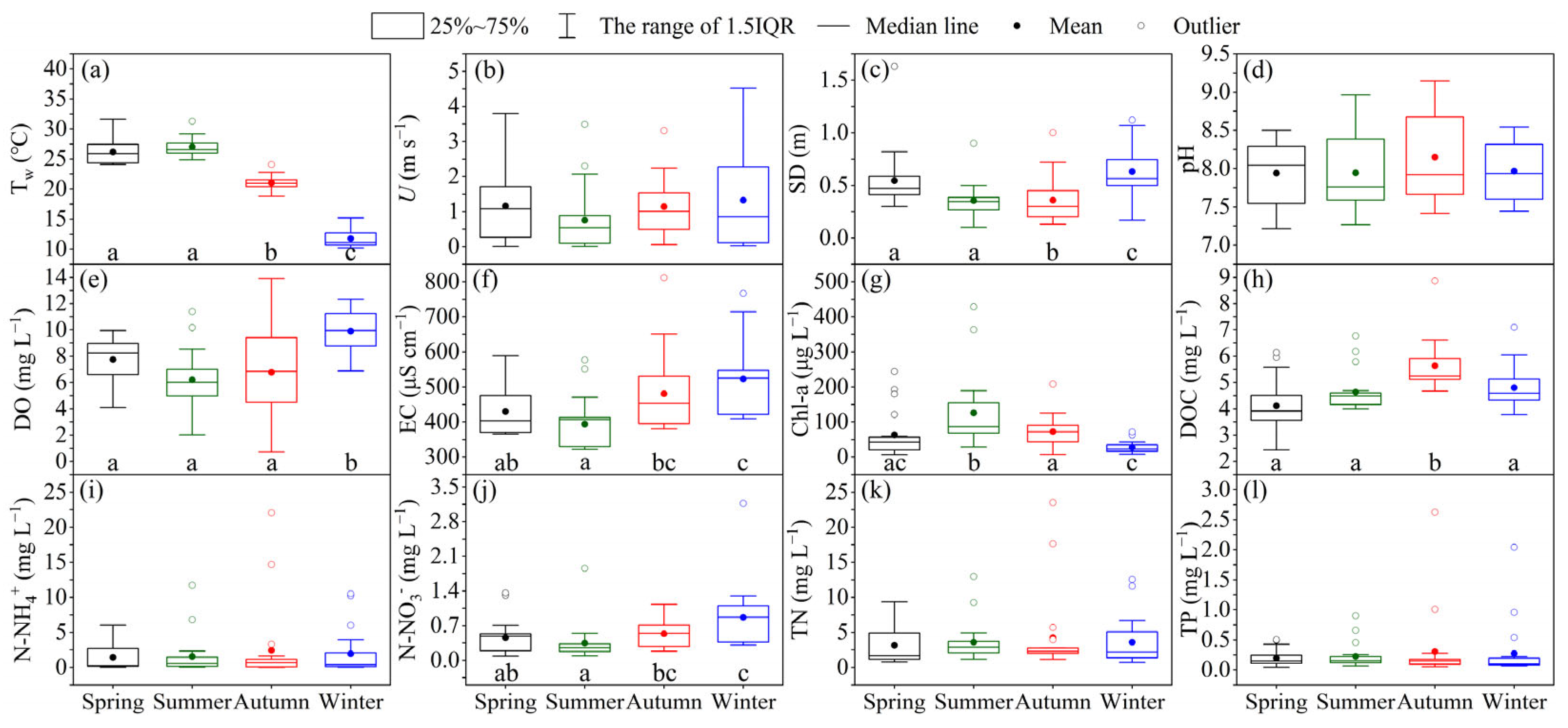
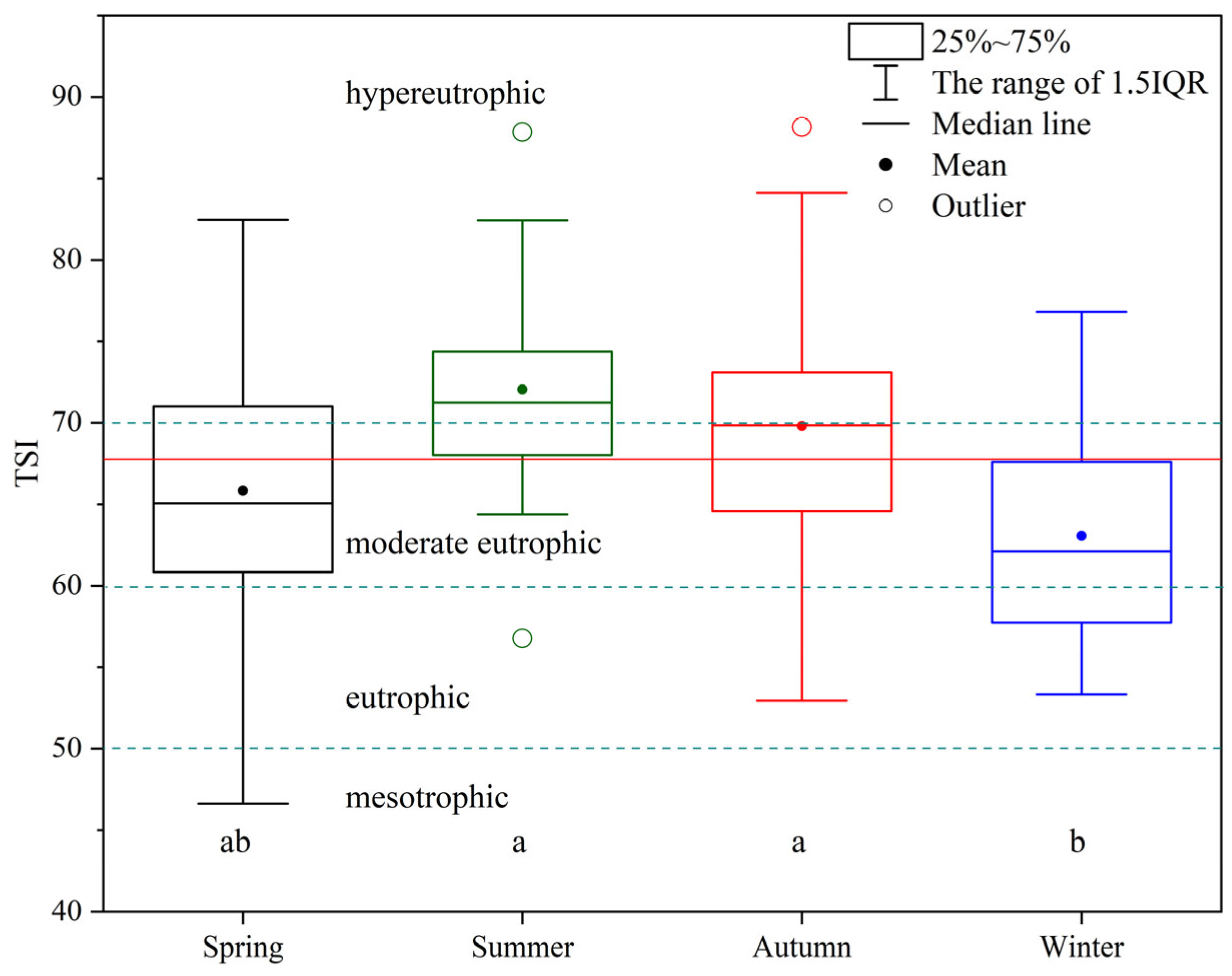
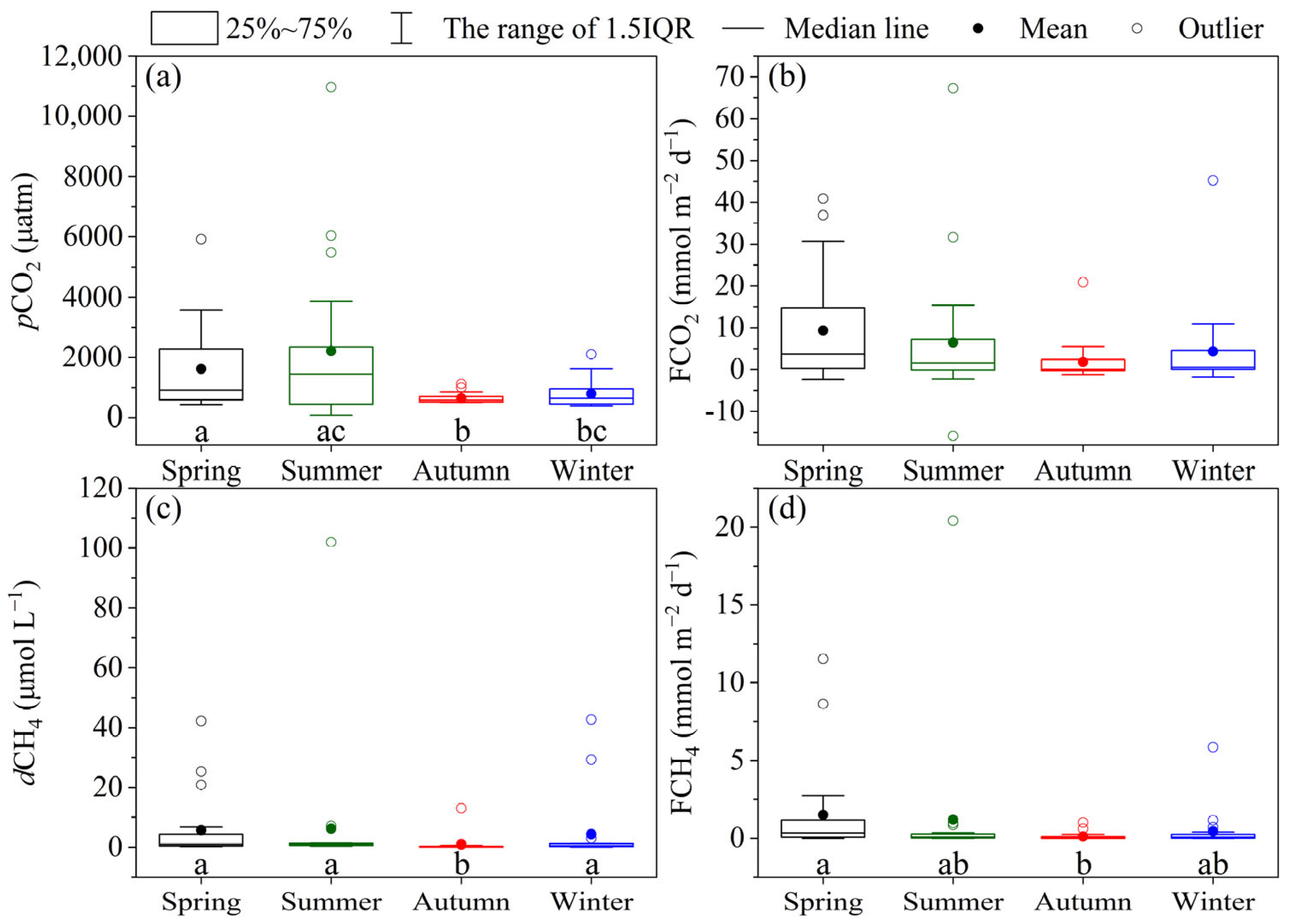
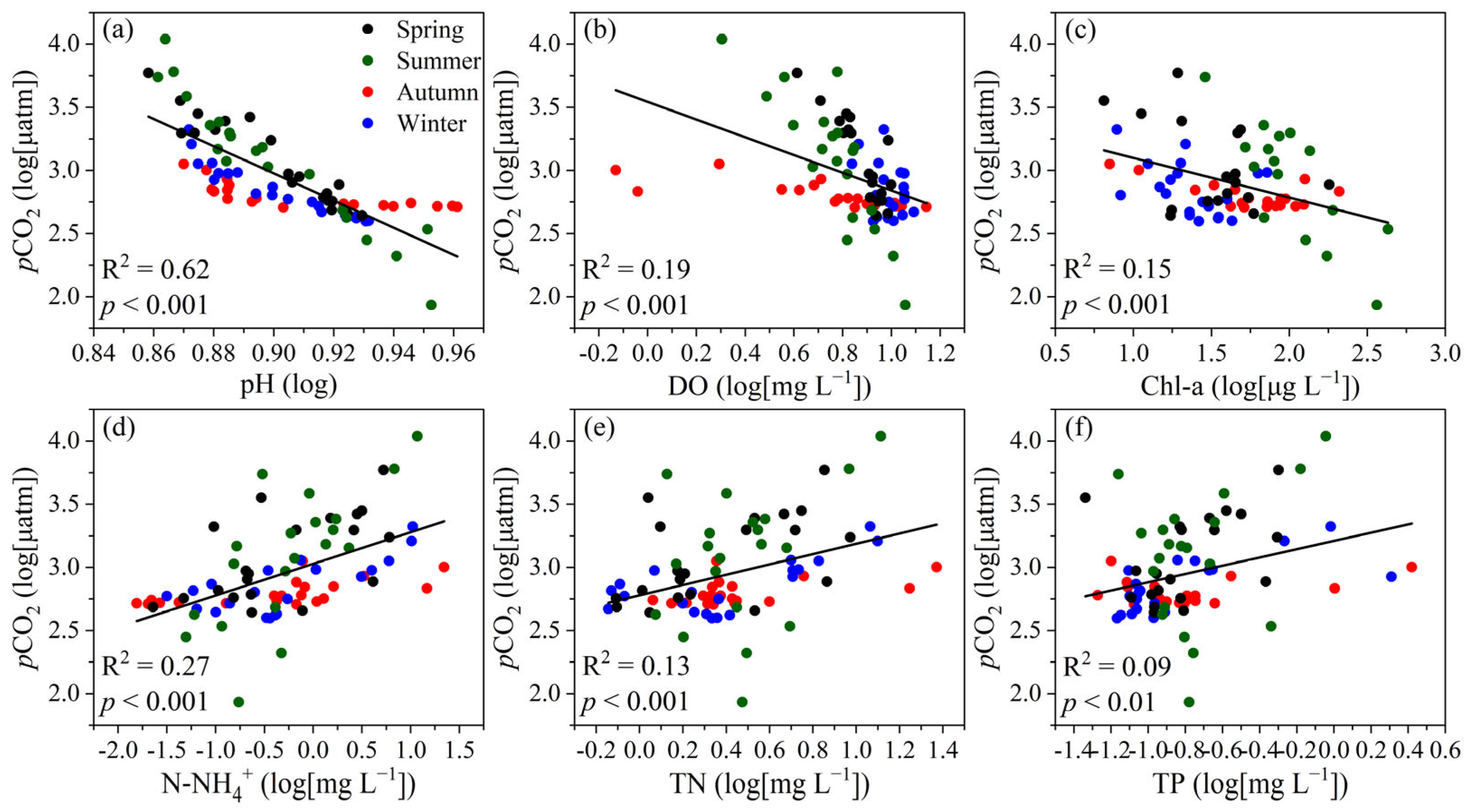
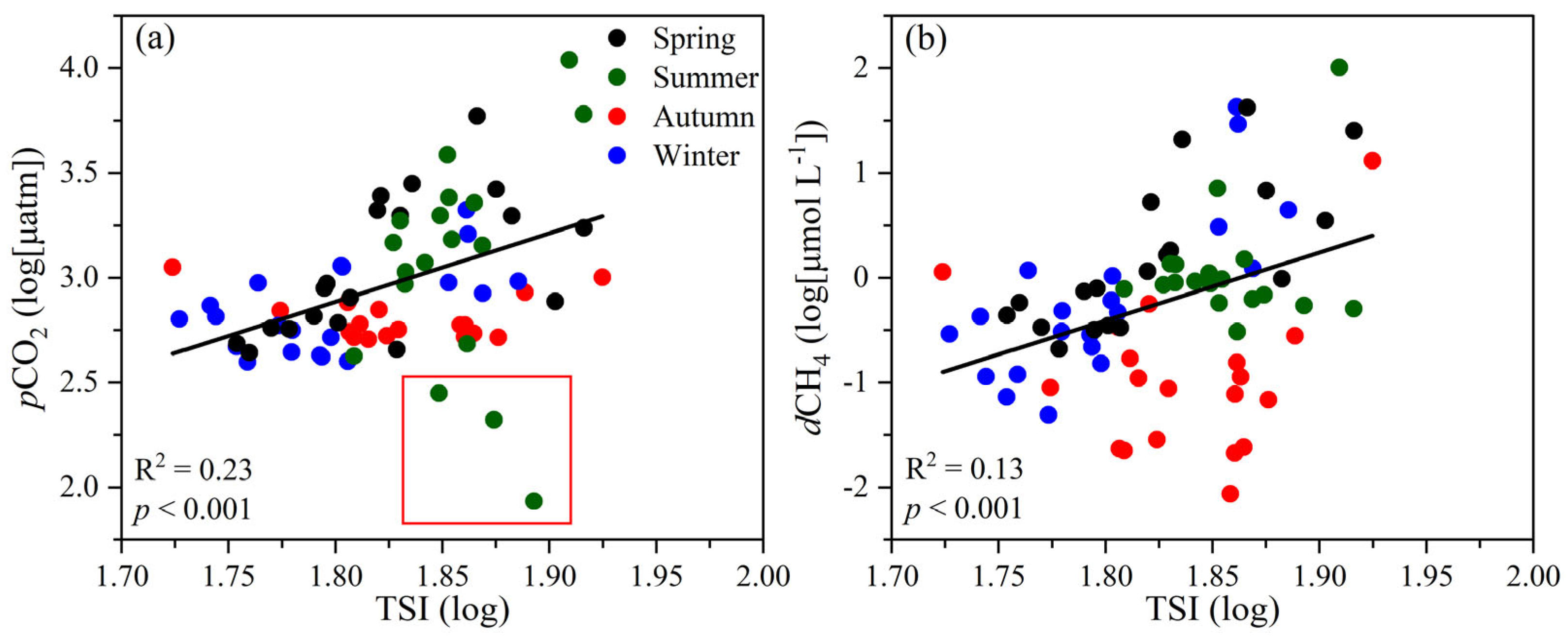
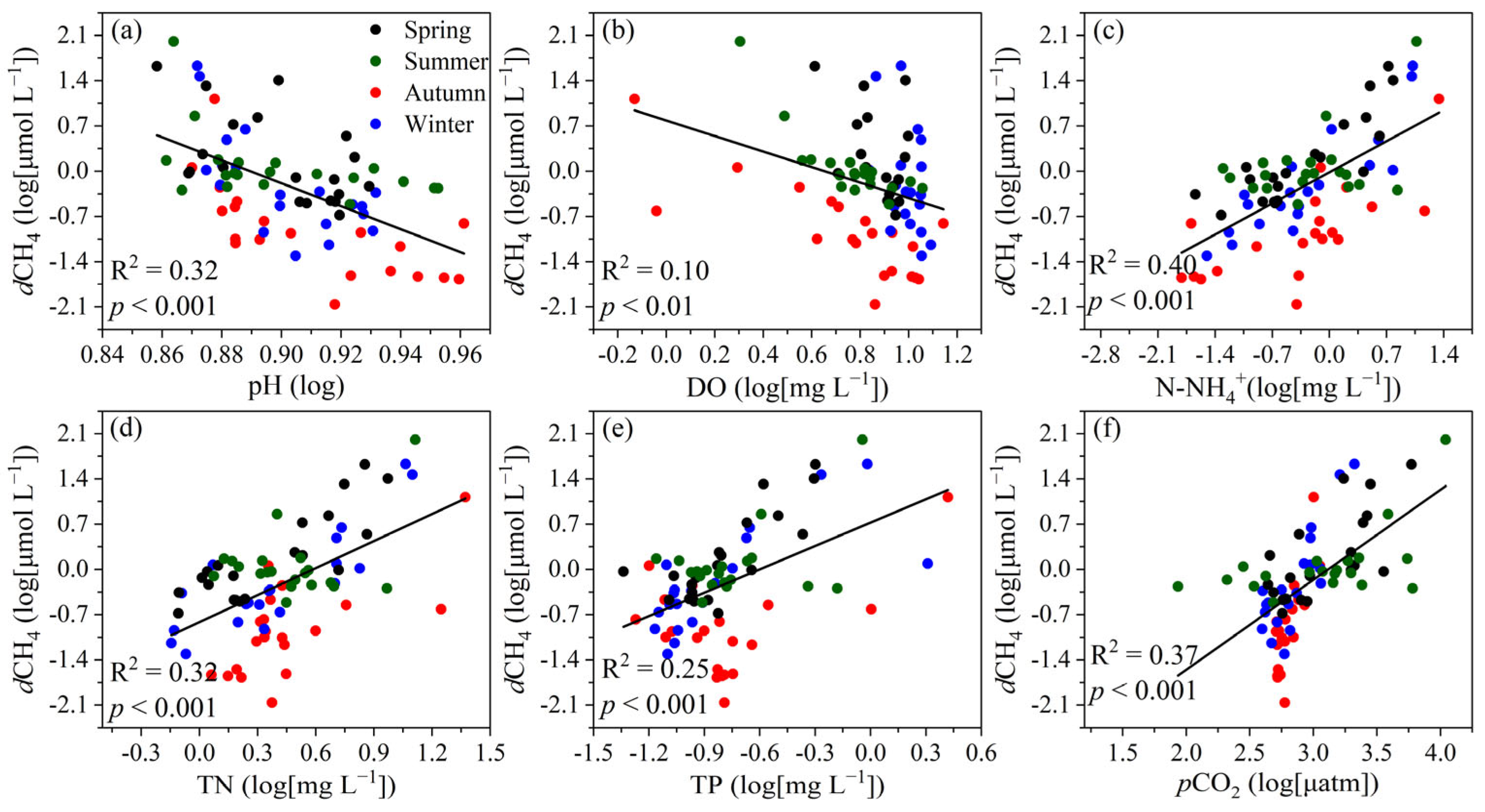
| CO2 | CH4 | |
|---|---|---|
| Multiple regression | pCO2 = 2.61 + 0.29N-NH4+ − 0.23N-NO3− − 0.36Chl-a + 0.72Tw | dCH4 = 2.00 + 0.41N-NH4+ − 0.89N-NO3− − 0.66Chl-a − 2.85DOC + 1.40TN |
| R2 | 0.44 | 0.59 |
| p | <0.001 | <0.001 |
| Part R2 | 0.27 ***, 0.05 *, 0.07 **, 0.05 ** | 0.40 *, 0.07 ***, 0.06 ***, 0.02 **, 0.04 ** |
Disclaimer/Publisher’s Note: The statements, opinions and data contained in all publications are solely those of the individual author(s) and contributor(s) and not of MDPI and/or the editor(s). MDPI and/or the editor(s) disclaim responsibility for any injury to people or property resulting from any ideas, methods, instructions or products referred to in the content. |
© 2023 by the authors. Licensee MDPI, Basel, Switzerland. This article is an open access article distributed under the terms and conditions of the Creative Commons Attribution (CC BY) license (https://creativecommons.org/licenses/by/4.0/).
Share and Cite
Ma, B.; Wang, Y.; Jiang, P.; Li, S. The Influence of Seasonal Variability of Eutrophication Indicators on Carbon Dioxide and Methane Diffusive Emissions in the Largest Shallow Urban Lake in China. Water 2024, 16, 136. https://doi.org/10.3390/w16010136
Ma B, Wang Y, Jiang P, Li S. The Influence of Seasonal Variability of Eutrophication Indicators on Carbon Dioxide and Methane Diffusive Emissions in the Largest Shallow Urban Lake in China. Water. 2024; 16(1):136. https://doi.org/10.3390/w16010136
Chicago/Turabian StyleMa, Bingjie, Yang Wang, Ping Jiang, and Siyue Li. 2024. "The Influence of Seasonal Variability of Eutrophication Indicators on Carbon Dioxide and Methane Diffusive Emissions in the Largest Shallow Urban Lake in China" Water 16, no. 1: 136. https://doi.org/10.3390/w16010136
APA StyleMa, B., Wang, Y., Jiang, P., & Li, S. (2024). The Influence of Seasonal Variability of Eutrophication Indicators on Carbon Dioxide and Methane Diffusive Emissions in the Largest Shallow Urban Lake in China. Water, 16(1), 136. https://doi.org/10.3390/w16010136







